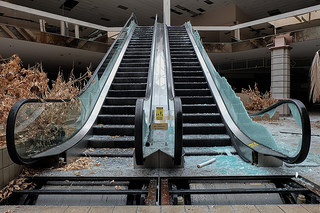Suburban American malls, ghost towns of the Digital Age, brick and mortars sacrificed at the altar of progress, were the way we lived until we just stopped. We’re far more efficient now, but what was lost in the transition? From David Uberti at the Guardian:
“It is hard to believe there has ever been any life in this place. Shattered glass crunches under Seph Lawless’s feet as he strides through its dreary corridors. Overhead lights attached to ripped-out electrical wires hang suspended in the stale air and fading wallpaper peels off the walls like dead skin.
Lawless sidesteps debris as he passes from plot to plot in this retail graveyard called Rolling Acres Mall in Akron, Ohio. The shopping centre closed in 2008, and its largest retailers, which had tried to make it as standalone stores, emptied out by the end of last year. When Lawless stops to overlook a two-storey opening near the mall’s once-bustling core, only an occasional drop of water, dribbling through missing ceiling tiles, breaks the silence.
‘You came, you shopped, you dressed nice – you went to the mall. That’s what people did,’ says Lawless, a pseudonymous photographer who grew up in a suburb of nearby Cleveland. “It was very consumer-driven and kind of had an ugly side, but there was something beautiful about it. There was something there.”
Gazing down at the motionless escalators, dead plants and empty benches below, he adds: ‘It’s still beautiful, though. It’s almost like ancient ruins.’
Dying shopping malls are speckled across the United States, often in middle-class suburbs wrestling with socioeconomic shifts.”
Tags: David Uberti, Seph Lawless

